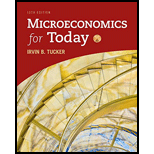
Micro Economics For Today
10th Edition
ISBN: 9781337613064
Author: Tucker, Irvin B.
Publisher: Cengage,
expand_more
expand_more
format_list_bulleted
Concept explainers
Question
Chapter 6.A, Problem 10SQ
To determine
The attaining of the consumer equilibrium.
Expert Solution & Answer
Want to see the full answer?
Check out a sample textbook solution
Students have asked these similar questions
The answer is not C
Social capital includes:
a) labour, produced capital, and natural capital.
b) human capital, physical capital, and natural resources.
c) labour, physical capital, and human capital.
d) labour, physical capital, and produced capital.
General Accounting Question solution and give me Blank ? C
Chapter 6 Solutions
Micro Economics For Today
Ch. 6.1 - Prob. 1YTECh. 6.1 - Prob. 2YTECh. 6.2 - Prob. 1YTECh. 6.A - Prob. 1SQPCh. 6.A - Prob. 2SQPCh. 6.A - Prob. 3SQPCh. 6.A - Prob. 1SQCh. 6.A - Prob. 2SQCh. 6.A - Prob. 3SQCh. 6.A - Prob. 4SQ
Ch. 6.A - Prob. 5SQCh. 6.A - Prob. 6SQCh. 6.A - Prob. 7SQCh. 6.A - Prob. 8SQCh. 6.A - Prob. 9SQCh. 6.A - Prob. 10SQCh. 6.A - Prob. 11SQCh. 6.A - Prob. 12SQCh. 6.A - Prob. 13SQCh. 6.A - Prob. 14SQCh. 6.A - Prob. 15SQCh. 6 - Prob. 1SQPCh. 6 - Prob. 2SQPCh. 6 - Prob. 3SQPCh. 6 - Prob. 4SQPCh. 6 - Prob. 5SQPCh. 6 - Prob. 6SQPCh. 6 - Prob. 7SQPCh. 6 - Prob. 8SQPCh. 6 - Prob. 9SQPCh. 6 - Prob. 10SQPCh. 6 - Prob. 1SQCh. 6 - Prob. 2SQCh. 6 - Prob. 3SQCh. 6 - Prob. 4SQCh. 6 - Prob. 5SQCh. 6 - Prob. 6SQCh. 6 - Prob. 7SQCh. 6 - Prob. 8SQCh. 6 - Prob. 9SQCh. 6 - Prob. 10SQCh. 6 - Prob. 11SQCh. 6 - Prob. 12SQCh. 6 - Prob. 13SQCh. 6 - Prob. 14SQCh. 6 - Prob. 15SQCh. 6 - Prob. 16SQCh. 6 - Prob. 17SQCh. 6 - Prob. 18SQCh. 6 - Prob. 19SQCh. 6 - Prob. 20SQCh. 6 - Prob. 21SQCh. 6 - Prob. 22SQCh. 6 - Prob. 23SQCh. 6 - Prob. 24SQCh. 6 - Prob. 25SQ
Knowledge Booster
Learn more about
Need a deep-dive on the concept behind this application? Look no further. Learn more about this topic, economics and related others by exploring similar questions and additional content below.Similar questions
- It is possible to use transformational leadership strategies to reach unethical objectives. Traditional leadership theories and morals standards are not adequate to help employees solve complex organizational issues. For the statement above, argue in position for both in favor or opposed to the statements.arrow_forwardDiscuss the preferred deterrent method employed by the Zambian government to combat tax evasion, monetary fines. As noted in the reading the potential penalty for corporate tax evasion is a fine of 52.5% of the amount evaded plus interest assessed at 5% annually along with a possibility of jail time. In general, monetary fines as a deterrent are preferred to blacklisting of company directors, revoking business operation licenses, or calling for prison sentences. Do you agree with this preference? Should companies that are guilty of tax evasion face something more severe than a monetary fine? Something less severe? Should the fine and interest amount be set at a different rate? If so at why? Provide support and rationale for your responses.arrow_forwardanswerarrow_forward
- Discuss the preferred deterrent method employed by the Zambian government to combat tax evasion, monetary fines. As noted in the reading the potential penalty for corporate tax evasion is a fine of 52.5% of the amount evaded plus interest assessed at 5% annually along with a possibility of jail time. In general, monetary fines as a deterrent are preferred to blacklisting of company directors, revoking business operation licenses, or calling for prison sentences. Do you agree with this preference? Should companies that are guilty of tax evasion face something more severe than a monetary fine? Something less severe? Should the fine and interest amount be set at a different rate? If so at why? Provide support and rationale for your responses.arrow_forwardNot use ai pleasearrow_forwardFor the statement below, argue in position for both in favor or opposed to the statement. Incompetent leaders can't be ethical leaders. Traditional leadership theories and moral standards are not adequate to help employees solve complex organizational issues.arrow_forward
- presentation on "Dandelion Insomnia." Poemarrow_forwardDon't used Ai solutionarrow_forward"Whether the regulator sells or gives away tradeable emission permits free of charge, the quantities of emissions produced by firms are the same." Assume that there are n identical profit-maximising firms where profit for each firm is given by π(e) with л'(e) > 0; π"(e) < 0 and e denotes emissions. Individual emissions summed over all firms gives E which generates environmental damages D(E). Show that the regulator achieves the optimal level of total pollution through a tradeable emission permit scheme, where the permits are distributed according to the following cases: Case (i) the firm purchases all permits; Case (ii) the firm receives all permits free; and Page 3 of 5 ES30031 Case (iii) the firm purchases a portion of its permits and receives the remainder free of charge.arrow_forward
- compare and/or contrast the two plays we've been reading, Antigone and A Doll's House.arrow_forwardPlease answer step by steparrow_forwardSuppose there are two firms 1 and 2, whose abatement costs are given by c₁ (e₁) and C2 (е2), where e denotes emissions and subscripts denote the firm. We assume that c{(e) 0 for i = 1,2 and for any level of emission e we have c₁'(e) # c₂' (e). Furthermore, assume the two firms make different contributions towards pollution concentration in a nearby river captured by the transfer coefficients ε₁ and 2 such that for any level of emission e we have C₂'(e) # The regulator does not know the resulting C₁'(e) Τι environmental damages. Using an analytical approach explain carefully how the regulator may limit the concentration of pollution using (i) a Pigouvian tax scheme and (ii) uniform emissions standards. Discuss the cost-effectiveness of both approaches to control pollution.arrow_forward
arrow_back_ios
SEE MORE QUESTIONS
arrow_forward_ios
Recommended textbooks for you

